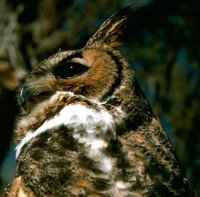Great Horned Owl
|
|
| Great Horned Owl | ||||||||||||||
|---|---|---|---|---|---|---|---|---|---|---|---|---|---|---|
 | ||||||||||||||
| Scientific classification | ||||||||||||||
| ||||||||||||||
| Binomial name | ||||||||||||||
| Bubo virginianus (Gmelin,, 1788) |
The Great Horned Owl, Bubo virginianus, is a very large owl.
Adults have large ear tufts, a reddish face, a white patch on the throat and yellow eyes. The ear tufts are not actually ears, but just tufts of fur. The underparts are light with brown barring; the upper parts are mottled brown. The legs and feet are covered in feathers up to the talons. There are regional variations in colour; birds farther north are paler.
Their breeding habitat is wooded or heavily shrubbed areas across North America and parts of South America. They often take over a nest used by some other large bird, sometimes adding feathers to line the nest but usually not much more.
They are permanent residents, but may wander after the nesting season.
These birds wait on a high perch at night and swoop down on prey. They mainly eat mammals, such as rats, mice, rabbits and skunks, and birds, as well as smaller owls. In northern regions, they may let uneaten food freeze and then thaw it out later using their own body heat. They have excellent hearing and exceptional vision in low light conditions.
Unlike human hearing, Owls have a sort of depth perception to their hearing, above and beyond "louder is closer". This is possible because owl ears are not placed in the same position on either side of their head: the right ear is typically set higher in the skull and at a slightly different angle. By tilting or turning their head until the sound is the same in each ear the owl can pinpoint both the direction and precise distance to the source of a sound.
The call is a low-pitched hoo hoo hoo hoo, sometimes with five syllables rather than four.
The Great Horned Owl is the provincial bird for Alberta.de:Virginia-Uhu nl:Amerikaanse oehoe
